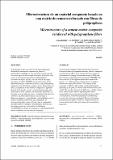Por favor, use este identificador para citar o enlazar a este item:
http://hdl.handle.net/10261/25933COMPARTIR / EXPORTAR:
 SHARE SHARE
 CORE
BASE CORE
BASE
|
|
| Visualizar otros formatos: MARC | Dublin Core | RDF | ORE | MODS | METS | DIDL | DATACITE | |

| Campo DC | Valor | Lengua/Idioma |
|---|---|---|
| dc.contributor.author | Rincón López, Jesús María | - |
| dc.contributor.author | Romero, Maximina | - |
| dc.contributor.author | Hernández, M. S. | - |
| dc.contributor.author | Talero Morales, Rafael | - |
| dc.contributor.author | García-Santos, A. | - |
| dc.date.accessioned | 2010-07-02T11:45:40Z | - |
| dc.date.available | 2010-07-02T11:45:40Z | - |
| dc.date.issued | 2004-06-30 | - |
| dc.identifier.citation | Materiales de Construcción 54(274): 73-82 (2004) | en_US |
| dc.identifier.issn | 0465-2746 | - |
| dc.identifier.uri | http://hdl.handle.net/10261/25933 | - |
| dc.description | 10 páginas, 7 figuras, 4 tablas. | en_US |
| dc.description.abstract | [ES] Se ha llevado a cabo una observacíón microestructural detallada de un material compuesto de fibras de polipropileno embebidas en una matriz de cemento usando los nuevos tipos de microscopía electrónica de barrido, tales como: un microscopio electrónico medioambiental (acrónimo en inglés: ESEM) y uno de emisión de campo (acrónimo en inglés: FESEM). La microestructura de las diferentes fases que componen la matriz es muy heterogénea, aunque hay una distribución uniforme de las fibras dentro de ellas. La superficie de este material compuesto es diferente después del fraguado, curado y endurecimiento según qué zonas estén o no en contacto con las paredes del molde. La interfase entre las diferentes fases cristalinas de la matriz de cemento y las fibras dispersadas se ha observado a diferentes aumentos, comprobándose compatibilidad entre la matriz y las fibras poliméricas. Las propiedades de resistencia mecánica (tanto a flexión como a compresión) han sido también evaluadas, comprobándose la mejora de las mismas con el uso como aditivo de Melamina Formaldehido con lo que se consigue un reforzamiento de la matriz cementante en este material compuesto. | en_US |
| dc.description.abstract | [EN] The present investigation deals with the microstructural characterization of a composite material, which is comprised of polypropylene fibers in an cement matrix, by means of environmental scanning electron microscopy (ESEM) and field emission scanning electron microscopy (FESEM). The microstructure of the different phases that compose the matrix is very heterogeneous, though there is a uniform distribution of the fibers inside it. The surface of this composite is different after setting, cured and hardening depending if the zone is or not in touch with the walls of the mould. The interface between the different crystalline regions of the cement matrix and the dispersed fibers shows compatibility between the matrix and the polymeric fibers. The mechanical properties (compression and bending strength) have also been evaluated. The use of melamine formaldehyde as additive leads to a reinforcement of the cement matrix and to the improvement of the mechanical properties. | en_US |
| dc.description.sponsorship | Se agradece el apoyo financiero del Proyecto de Investigación Nº A-9907 de la Universidad Politécnica de Madrid. Esta investigación se ha efectuado gracias al Acuerdo MArco de Cooperación entre la Universidad Politécnica de Madrid (UPM) y el Consejo Superior de Investigaciones Científicas (CSIC). | en_US |
| dc.format.extent | 2631244 bytes | - |
| dc.format.mimetype | application/pdf | - |
| dc.language.iso | spa | en_US |
| dc.publisher | Consejo Superior de Investigaciones Científicas (España) | en_US |
| dc.rights | openAccess | en_US |
| dc.subject | Material compuesto polímero/cemento (PMCs) | en_US |
| dc.subject | Microestructura | en_US |
| dc.subject | Polipropileno | en_US |
| dc.subject | Microscopía electrónica | en_US |
| dc.subject | ESEM | en_US |
| dc.subject | FESEM | en_US |
| dc.subject | Polymer/cement composite (PMCs) | en_US |
| dc.subject | Microstructure | en_US |
| dc.subject | Polypropylene | en_US |
| dc.subject | Electron microscopy | en_US |
| dc.title | Microestructura de un material compuesto basado en una matriz de cemento reforzado con fibras de polipropileno | en_US |
| dc.title.alternative | Microstructure of a cement matrix composite reinforced with polypropylene fibers | en_US |
| dc.type | artículo | en_US |
| dc.identifier.doi | 10.3989/mc.2004.v54.i274.234 | - |
| dc.description.peerreviewed | Peer reviewed | en_US |
| dc.relation.publisherversion | http://dx.doi.org/10.3989/mc.2004.v54.i274.234 | en_US |
| dc.identifier.e-issn | 1988-3226 | - |
| dc.type.coar | http://purl.org/coar/resource_type/c_6501 | es_ES |
| item.openairetype | artículo | - |
| item.grantfulltext | open | - |
| item.cerifentitytype | Publications | - |
| item.openairecristype | http://purl.org/coar/resource_type/c_18cf | - |
| item.fulltext | With Fulltext | - |
| item.languageiso639-1 | es | - |
| Aparece en las colecciones: | (IETCC) Artículos | |
Ficheros en este ítem:
| Fichero | Descripción | Tamaño | Formato | |
|---|---|---|---|---|
| 280.pdf | 2,57 MB | Adobe PDF |  Visualizar/Abrir |
CORE Recommender
SCOPUSTM
Citations
5
checked on 18-abr-2024
WEB OF SCIENCETM
Citations
3
checked on 24-feb-2024
Page view(s)
590
checked on 19-abr-2024
Download(s)
250
checked on 19-abr-2024
Google ScholarTM
Check
Altmetric
Altmetric
NOTA: Los ítems de Digital.CSIC están protegidos por copyright, con todos los derechos reservados, a menos que se indique lo contrario.
